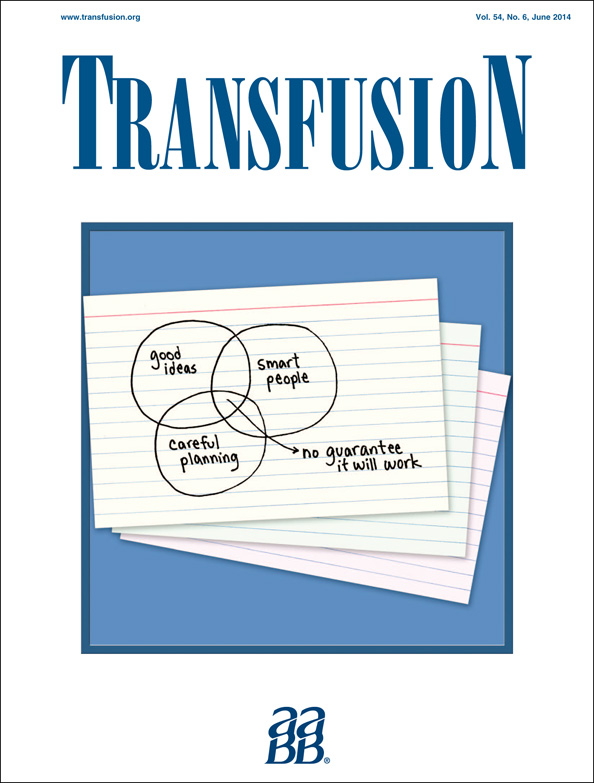How do we use molecular red blood cell antigen typing to supplement pretransfusion testing?
Corresponding Author
Suneeti Sapatnekar
Section of Transfusion Medicine, Department of Clinical Pathology, Robert J. Tomsich Pathology & Laboratory Medicine Institute, Cleveland Clinic, Cleveland, Ohio
Address reprint requests to: Suneeti Sapatnekar, MD, PhD, Section of Transfusion Medicine, Desk Q6-2, Robert J. Tomsich Pathology & Laboratory Medicine Institute, Cleveland Clinic, 9500 Euclid Avenue, Cleveland, OH 44195; e-mail: [email protected].Search for more papers by this authorPriscilla I. Figueroa
Section of Transfusion Medicine, Department of Clinical Pathology, Robert J. Tomsich Pathology & Laboratory Medicine Institute, Cleveland Clinic, Cleveland, Ohio
Search for more papers by this authorCorresponding Author
Suneeti Sapatnekar
Section of Transfusion Medicine, Department of Clinical Pathology, Robert J. Tomsich Pathology & Laboratory Medicine Institute, Cleveland Clinic, Cleveland, Ohio
Address reprint requests to: Suneeti Sapatnekar, MD, PhD, Section of Transfusion Medicine, Desk Q6-2, Robert J. Tomsich Pathology & Laboratory Medicine Institute, Cleveland Clinic, 9500 Euclid Avenue, Cleveland, OH 44195; e-mail: [email protected].Search for more papers by this authorPriscilla I. Figueroa
Section of Transfusion Medicine, Department of Clinical Pathology, Robert J. Tomsich Pathology & Laboratory Medicine Institute, Cleveland Clinic, Cleveland, Ohio
Search for more papers by this authorAbstract
The molecular basis of many blood group antigens is known, and it provides a means for predicting the red blood cell phenotype. Molecular typing methods are useful when serologic typing cannot be performed, due to sample or reagent limitations. We discuss the implementation of a commercial molecular typing assay at our Transfusion Service, the indications for testing, and the advantages and drawbacks of the assay. We also present our algorithm for selecting candidates for testing.
References
- 1 Reid ME, Toy PT. Simplified method for recovery of autologous red blood cells from transfused patients. Am J Clin Pathol 1983; 79: 364-366.
- 2 Kosanke J. EDTA glycine acid treatment of red blood cells. Immunohematology 2012; 28: 95-96.
- 3 Daniels G. The molecular genetics of blood group polymorphisms. Hum Genet 2009; 126: 729-742.
- 4 Reid ME, Rios M, Yazdanbakhsh K. Applications of molecular biology techniques to transfusion medicine. Semin Hematol 2000; 37: 166-176.
- 5 Lomas-Francis C, DePalma H. DNA-based assays for patient testing: their application, interpretation, and correlation of results. Immunohematology 2008; 24: 180-190.
- 6 Ribiero KR, Guarnieri MH, da Costa DC, et al. DNA array analysis for red blood cell antigens facilitates the transfusion support with antigen-matched blood in patients with sickle cell disease. Vox Sang 2009; 97: 147-152.
- 7 Storry JR, Olsson M. Genetic basis of blood group diversity. Br J Haematol 2004; 126: 759-771.
- 8 Denomme GA. Molecular basis of blood group expression. Transfus Apher Sci 2011; 44: 53-63.
- 9 Hashmi G, Shariff T, Zhang Y, et al. Determination of 24 minor red blood cell antigens for more than 2000 blood donors by high-throughput DNA analysis. Transfusion 2007; 47: 736-747.
- 10
Klapper E. Implementation of HEA BeadChip system at medical centers: providing extended matched units and eliminating complex workups for patients. In: JM Moulds, PM Ness, SR Sloan, editors. Beadchip molecular immunohematology. New York: Springer Science+Business Media; 2011. p. 57-71.
10.1007/978-1-4419-7512-6_5 Google Scholar
- 11 Hashmi G, Shariff T, Seul M, et al. A flexible array format for large-scale, rapid blood group DNA typing. Transfusion 2005; 45: 680-688.
- 12 Daniels G, Faas BH, Green CA, et al. The VS and V blood group polymorphisms in Africans: a serologic and molecular analysis. Transfusion 1998; 38: 951-958.
- 13 Hillyer CD, Shaz BH, Winkler AM, et al. Integrating molecular technologies for red blood typing and compatibility testing into blood centers and transfusion services. Transfus Med Rev 2008; 22: 117-132.
- 14 Westhoff CM. The potential of blood group genotyping for transfusion medicine. Immunohematology 2008; 24: 190-195.
- 15 Whorley T, Vege S, Kosanke J, et al. JK alleles associated with altered Kidd antigen expression. Transfusion 2009; 49(Suppl): 48A-49.
- 16 Josephson CD, Su LL, Hillyer KL, et al. Transfusion in the patient with sickle cell disease: a critical review of the literature and transfusion guidelines. Transfus Med Rev 2007; 21: 118-133.
- 17 Castilho L, Credidio DC, Ribeiro K, et al. Anti-Fy3 in sickle cell disease patients genotyped as FY*B-33/FY*B-33. Transfusion 2009; 49(Suppl): 35A.
- 18 Chou ST, Westhoff CM. The role of molecular immunohematology in sickle cell disease. Transfus Apher Sci 2011; 44: 73-79.
- 19 Chou ST, Jackson T, Vege S, et al. High prevalence of red blood cell alloimmunization in sickle cell disease despite transfusion from Rh-matched minority donors. Blood 2013; 122: 1062-1071.
- 20 Wenk RE, Chiafari FA. DNA typing of recipient blood after massive transfusion. Transfusion 1997; 37: 1108-1110.
- 21 Reid ME, Rios M, Powell VI, et al. DNA from blood samples can be used to genotype patients who have recently received a transfusion. Transfusion 2000; 40: 48-53.
- 22 Klapper E, Zhang Y, Figueroa P, et al. Toward extended phenotype matching: a new operational paradigm for the transfusion service. Transfusion 2010; 50: 536-546.
- 23 Wilkinson K, Harris S, Gaur P, et al. Molecular blood typing augments serologic testing and allows for enhanced matching of red blood cells for transfusion in patients with sickle cell disease. Transfusion 2012; 52: 381-388.




